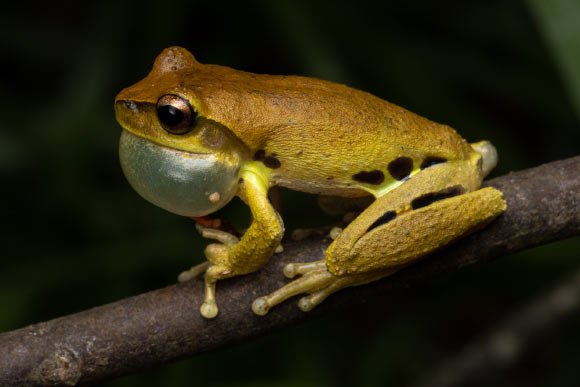Biologists have discovered a new species — and redescribed another one — of the tree frog genus Litoria living on the Australian continent.

The whirring tree frog (Litoria revelata). Image credit: Stephen Mahony.
Litoria is a large genus of tree frogs native to Australia, the Bismarck Archipelago, the Solomon Islands, New Guinea, the Lesser Sunda Islands, and the Moluccan Islands.
The genus includes around 100 species and belongs to the monotypic subfamily Litoriinae within the family Pelodryadidae.
The newly-discovered species, named the Eungella whirring frog (Litoria eungellensis), inhabits a mere 20 km2 in the cool montane temperature forest of Queensland’s Engella Range, only above 900 m elevation.
This frog is separated by hundreds of km from its nearest relative, the redescribed species Atherton whirring frog (Litoria corbeni).
These two species survive only in isolated, cool, and moist upland environments, with little to no opportunity to shift habitats as temperatures rise.
“The mantra of ‘adapt or perish’ doesn’t equally apply across species,” said University of Newcastle’s Professor Michael Mahony.
“The frogs are literally running out of space. Isolated on mountaintops, with climate models predicting warmer and drier conditions, they have nowhere left to go.”
“We observed that the unusual distribution and genetic divergence between the species provides important information about Australia’s climate in the past and how that has molded the current distribution of the frog,” said Dr. Luke Price, a researcher at South Australian Museum.
“Because the whirring tree frog occurs only in wet forest habitats, it must once have occupied wet forest habitats that were interconnected along the Great Dividing Range from north-eastern New South Wales to the Atherton Tablelands at a time of cooler and moister climate than we experience at present.”
“We are not talking about climate warming associated with human impacts and the greenhouse effect, but much older changes associated with movement of the continents and global weather circulation.”
The researchers also revealed that Litoria eungellensis and Litoria corbeni, despite their similar appearances — bright mustard yellowish bodies with red patches hidden behind their legs — have been evolving separately for at least 1.5 million years.
Subtle differences in their mating calls and genetic analyses confirmed their distinct evolutionary paths.
“Litoria eungellensis now holds the unenviable title of one of Australia’s top ten frogs with the smallest natural range,” Dr. Price said.
“Species confined to such tiny areas face immense risks — from wildfires to pollution events. One catastrophic event could wipe them out entirely.”
“The observation that the species is restricted to an isolated patch of high elevation cool rainforest habitat suggests that it is already living at its biological limits, and with climate warming the species has nowhere to expand or migrate.”
“A similar situation occurs for Litoria corbeni, but it has a slightly larger distribution.”
Both species meet the International Union for Conservation of Nature’s criteria for being listed as Critically Endangered, primarily due to their limited distributions and the mounting threat of climate change.
“These frogs are already living at their biological limits,” Professor Mahony said.
“With nowhere to migrate, their survival hinges on proactive conservation efforts.”
Meanwhile, the more widespread Litoria revelata found in New South Wales and southeastern Queensland appears less threatened.
“However, the apparent stability of Litoria revelata might be more because there is no formal surveillance for this species and his assessment that it is not threatened is based on observations from interested biologists and community scientists only,” Dr. Price said.
This discovery highlights the pressing need to understand and mitigate the impacts of climate change on vulnerable species.
“We need to recognize that not all species can adapt quickly enough,” Professor Mahony said.
“Targeted conservation and habitat protection are essential to prevent these unique frogs from vanishing forever.”
The findings appear in the journal Zootaxa.
_____
Luke C. Price et al. 2025. Systematic evaluation of molecular genetic, morphological and acoustic variation reveals three species in the Litoria revelata complex (Anura: Pelodryadidae). Zootaxa 5584 (3): 301-338; doi: 10.11646/zootaxa.5584.3.1











